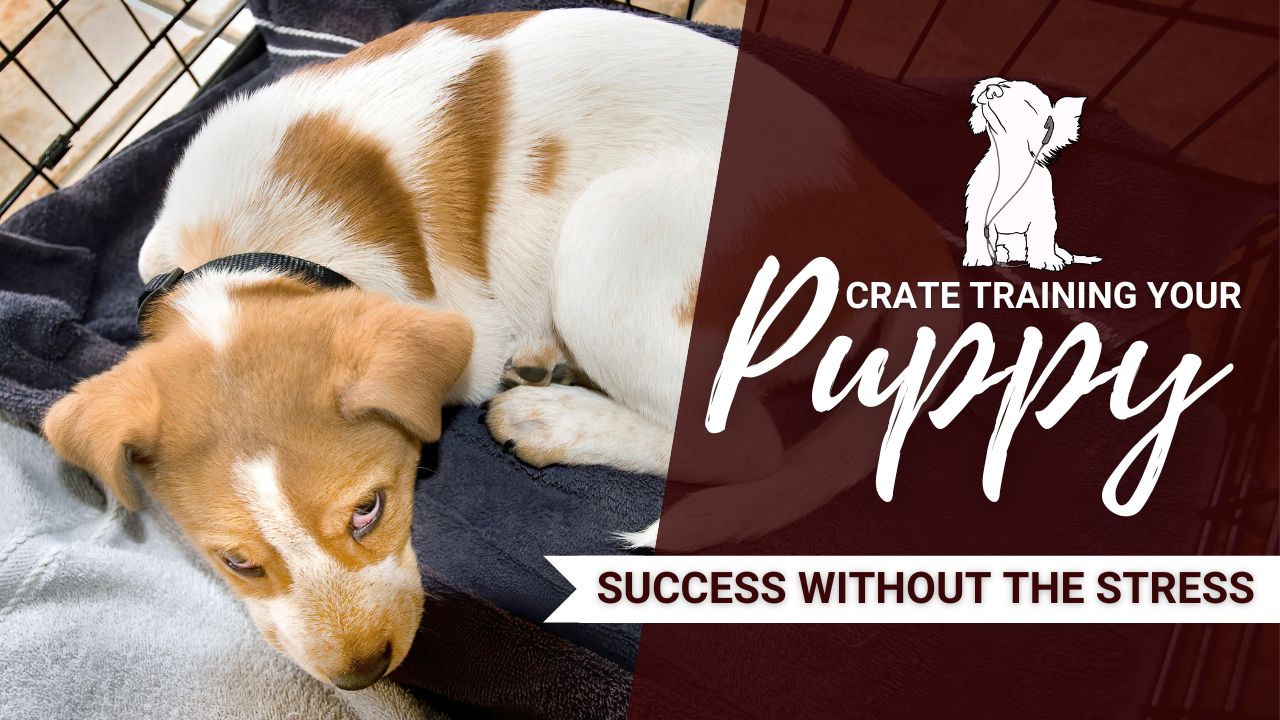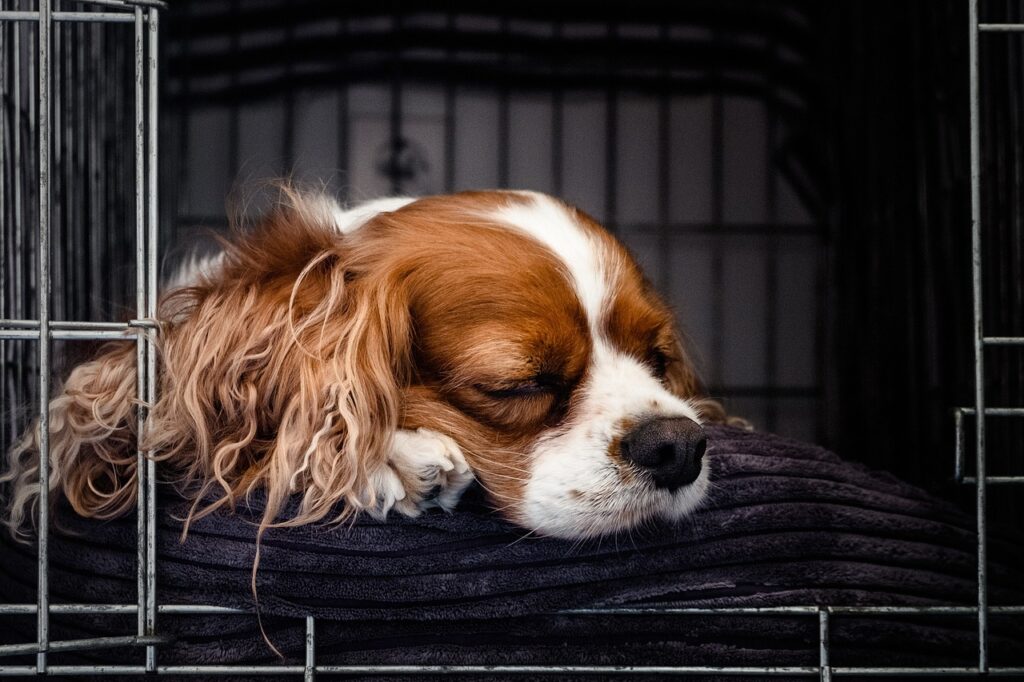Crate Training A Puppy Made Easy: Guarantee Success WITHOUT Stress

Crate training a puppy has so many benefits for both owners and puppies alike… Speaking from first-hand experience, if there’s only one thing you can absolutely nail during your puppy’s first few weeks at home – make crate training it!
Crate training a dog is not cruel, it’s not dangerous, and it’s not selfish – done properly, crate training will enable you to keep your puppy safe at all times, minimise the development of fears, phobias or anxieties as your puppy grows into adulthood, and encourage a calm and contented character.
Of course, if you get crate training wrong, it can have entirely the opposite effect… So how can you be sure you’re tackling puppy crate training the right way?
Check out our top tips below, and learn exactly how to train your puppy to love their crate, without stressing out them… and without stressing out yourself!
Training a Puppy To Love Their Crate
To ensure your crate training journey is a successful one, the main goal is to convince your puppy of ONE thing: that the crate is the best place to be on earth!
So… don’t rush to shut your puppy in the crate. If you start closing that crate door before your puppy has decided that the crate is their happy place, you will slow down your rate of progress immensely! Obviously the end goal is for the puppy to get shut in… but forget that for now.
Instead, your initial focus need only be on all the different ways we can convince your new four-legged friend that the crate is a portal to unimaginable joy, and nothing else!
Here’s a Few Tips…
1. As soon as you bring puppy home, ensure the crate is in situ, with the door secured open (use a clip or a short piece of string to do this – we do not want the puppy to wander in and accidentally knock the door closed behind himself at this stage) and whenever your puppy is NOT looking, sprinkle a few tasty morsels in there for him to find. It could be his regular kibble, a couple of small pieces of cheese, maybe a piece of ham… anything tasty. Once you’ve done this, don’t usher him towards it, or point it out, just leave it and go about your business. He may not find it for 3 hours the first time – that’s fine. But when he does wander in and find it, we want him to associate it with the crate, and not you.
2. Since our singular goal at the beginning of our journey crate training a puppy is to grow as much positive association with the crate as possible, it’s a great idea to link as many enjoyable experiences as you can with the crate itself, to supercharge your success. An example of this could be ensuring all meal times happen inside the crate, if your pup really enjoys dinnertime. By taking an experience that occurs as regularly as mealtime and pairing it with the crate, you ensure you are setting up multiple positive experiences each day, with an activity that was going to happen anyway!
3. As well as using mealtimes to your advantage, you can also set up long-lasting enrichment toys or feeders in the crate, so they cannot be removed. For example, you could secure a licky mat inside the crate (varieties are available with suction cup bases) that’s loaded with something smelly, so your pup is able to sniff it out for himself and then be rewarded for going inside his crate.
Likewise, you could fill a kong and then secure it to the back of the crate interior, so that, once again, it can only be enjoyed inside the crate. The reason securing the treats inside is important, is that we want the full value of the treat experience to be associated with staying inside the crate – rather than simply allowing puppy to enter the crate to retrieve a treat, and then leave to enjoy it elsewhere.
Your Puppy Needs to Disassociate The Crate From You
Dogs are highly intelligent animals, and are more than capable of working out where the value lies. If the crate is only ever rewarding when they see you interfere or engage with it, they’ll quickly work out that you are the source of all the yummy rewards that keep showing up – if this happens, you’ll end up with a dog more interested in investigating your behaviours, than investigating their crate – which is what we want. So whenever possible, try to restock or ‘set up’ the crate when your puppy is sleeping, out of the room or otherwise engaged to begin with.
This way, we teach the puppy not that the crate is fun when the human has touched it, but that the crate is randomly fun, at any given moment, and there is NO predictor of when the next jackpot inside the crate will appear! If your puppy believes this, they will begin to investigate it of their own accord, multiple times per day, and eventually perhaps even make the choice to hang out in it and wait for a while, to see if anything good shows up. If this happens, you know you’re doing a great job!
To this end, ensure the crate is always open and always accessible to them, so that this investigate + reward pattern is repeated plenty of times throughout the day.
Your Puppy Can Only Handle One Thing At A Time
Something I get asked a lot about with regards to crate training is ‘how do we combine it with night-time training, if it’s supposed to be such a slow and steady process?’ And my response is always this: puppies can only handle one thing at a time.
If you step back and consider what they’ve been through during the past 48 – 72 hours when they first come home with you… it’s A LOT.
Removed from the only home environment they’ve ever known, suddenly without the comfort and familiarity of their mother and littermates who they’ve never spent a moment apart from until now, subjected to a potentially long drive in a car (which is a wild experience in itself if you’ve never done that before!) with a group of humans you’ve never met, to a new home FILLED with overwhelming sights, sounds and smells.
Your puppy is already processing a lot of change in a very short window of time, so to expect them to also deal with being shut in a crate, with no company for 6 hours when you all head off to bed is a big ask. For this reason, I always recommend that separation training is put on the back burner for a week or two at the very least… which means the crate is coming to bed with you!
For a run-through of exactly how to work night-time crate training with your puppy and grow their independence the stress-free way, check out my video below…
@listendogtraining Puppy crying and keeping you awake all night? House training taking forever? Dont worry – we’ve totally got this…! 💪😁 Save this video for: 🐶 A step-by-step guide on handling your pup’s first night at home 🐶 My proven method for night-time sleep and independence training 🐶 The night-time hack that’s going to speed up the entire toilet training process! 🙌 #newpuppyowner #newpuppymom #puppytrainingtips #puppytraining101 #puppysleeping #dogtrainersoftiktok #dogtraininghack
By adopting this approach, you’ll not only be giving yourself a powerful headstart on getting your puppy’s toilet-training off to a fantastic start, but you’ll be ensuring you raise a confident, happy and relaxed dog from day one.
Want to kickstart your dog training journey with a plan for success? Subscribe to receive three of my favourite printable planners – for FREE!
Got any questions? Come find me on Insta or TikTok and drop me a message – always happy to chat dog training! And if you are bringing home a new puppy soon and want to ensure your training is a roaring success, check out our range of printable planners and guides, designed to help you set goals, and track important things like socialisation, toilet training, puppy classes and more.





